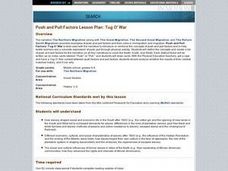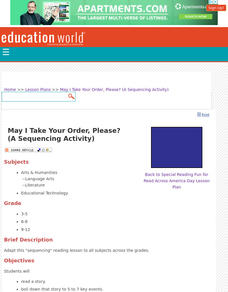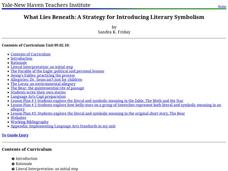Curated OER
Abraham Lincoln and Frederick Douglass: A Compare and Contrast Lesson Plan
Two great men, one time period, and one purpose; it sounds like a movie trailer, but it's not. It's a very good comparative analysis lesson focused on Abraham Lincoln and Frederick Douglass. Learners will research and read informational...
Curated OER
Push and Pull Factors: Tug O' War
Pupils analyze the factors that led to migration in the 19th century including the forces that drew people to resettle as well as to return a place where they previously lived.
Curated OER
Civil War Time Line
Pupils draw a time line on graph paper on a scale of one square to every five years beginning in 1770 and ending at 2000. They place historic events and inventions in their correct time period on the time line, and add their birthday to it.
Curated OER
The Student Newspaper on World War I
Students explore WW I through the publication of a completely student-compiled newspaper.
Curated OER
Lesson 4. Killing Fields
Eleventh graders describe several of the WWI's bloodiest battles, track the battles' progression to determine advances made by leading nations, and write frontline journalistic accounts of one or more of the battles.
Curated OER
The Great Debate: Internationalists vs. Isolationists
High schoolers examine the opposing arguments of the isolationists and internationalists in 1941. In this debate instructional activity, the students are divided into two opposing groups representing a position in a live, in- class...
Curated OER
Fun Field Trip Funding Ideas
Whether it's a lack of funds or lack of time, check out these great ideas for getting creative with field trips.
Curated OER
Was There an Industial Revolution? Americans at Work Before the Civil War
Young scholars tabulate the First Industrial Revolution where a significant number of inventions and innovations appeared transforming American life. Cite examples of change (ex. telegraph) in the lives of Americans during the era of...
Curated OER
May I Take Your Order, Please?
Pupils read a story, boil down that story to 5 to 7 key events, create a sequencing quiz to go with the story and have their classmates take the quiz. They will the strategy of sequencing by reading various stories (that they are not...
Curated OER
Surviving Hitler
Are you thinking of reading Surviving Hitler with your class? If so, you will find these worksheets to be useful. They include great activities which are designed to help your readers respond to the book. Predicting events and a chart...
Yale University
What Lies Beneath: A Strategy for Introducing Literary Symbolism
“It’s not about what it is, it’s about what it can become.” You’re never too old for Dr. Seuss and using The Sneetches and The Lorax is a great way to introduce readers to allegories, parables, and literary symbolism. The lessons...
Dick Blick Art Materials
Artist’s Challenge Coins
Make 'em, trade 'em, share 'em. Kids create artist's challenge coins to celebrate personal achievements, as mementos, or as encouragement. Originally designed for service personnel, these coins are a great way to recognize achievement.
Stanford University
Chicago Race Riots of 1919
Learners explore the Chicago Race Riots of 1919. In this American history lesson, students watch the move "Up South" regarding the African American migration following World War I. Learners read primary documents regarding the race riots...
Curated OER
Cotton
Discover facts about cotton, farming, and economic growth in this engaging lesson. As each question is read, one of ten solid tiles covering an illustration of a cotton plant is removed. Students use the verbal and visual clues to...
Curated OER
Armenian Genocide
As your historians examine the beginnings of WWI, ensure they are familiar with the Armenian Genocide. This basic introductory lesson plan utilizes teacher-led discussion, map analysis, and a Socratic seminar. Not much detail is offered...
Curated OER
Art Imitates Life
Elementary and middle schoolers examine postcards depicting World War I events. Eventually, they create prints that reflect their own lives. In an interesting blend of history and current events, this instructional activity should engage...
DocsTeach
Pearl Harbor Dispatch Analysis
Scholars play a historical version of the telephone game when they analyze the dispatch from the Pearl Harbor attack. The quick activity uses primary sources to help academics analyze an historical event. Young historians also complete a...
DocsTeach
Introduction to the Domino Theory and Containment Policy in Vietnam
Scholars analyze a propaganda poster against communism. The resource uses the poster to examine the domino theory and containment policies used by the United States to stop the spread of communism in Vietnam. Scholars work in pairs or...
Common Core Sheets
Reading a Timeline
Sometimes the most important details of an informational text aren't within the text at all. Teach your class how to read timeline with a set of activities that prompts them to find specific dates and events on the timelines, as well as...
DocsTeach
Apollo-Soyuz: Space Age Detente
The Space Race saw the Soviet Union and the US go from competitors to partners. Scholars read a letter regarding the first docking of the US and Soviet space craft. Young historians also complete a written assignment and participate in...
Curated OER
Lincoln, the Great Emancipator?
Students examine the motivating factors that prompted Lincoln to draft the Emancipation Proclamation in 1863. They examine Lincoln's social and political beliefs, particularly as they pertained to slavery and race in the United States.
PBS
The Roosevelts: An Intimate History—Snapshot Lessons
The Roosevelt family was one of the most influential and prominent political forces in the 20th century, leaving behind a wide-ranging legacy of conservation, progressivism, and economic growth. Learn more about President Theodore...
DocsTeach
Memorializing Abraham Lincoln in Washington, DC
The legacy of President Lincoln continues to endure. Scholars view images of three statues that have been created to honor President Lincoln. Academics analyze the three images and share their findings in a group discussion format. Young...
Curated OER
I Heard It Through the Grapevine
Students write a first-person narrative from the perspective of a runaway slave, or a historical character of the period, and present their story orally.

























